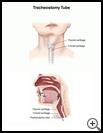
Tracheostomy: Emergency Care
________________________________________________________________________
KEY POINTS
- A tracheostomy is a surgery to make a small opening through the front of your child’s neck into the windpipe (trachea). A tube is then placed through the opening and into the windpipe. The tube keeps your child’s airway open and helps your child breathe by letting air flow into and out of the lungs. If the tube gets blocked or comes out accidentally, it is an emergency.
- If the tube gets blocked, suction the trach tube right away. If the symptoms continue, change the trach tube and suction again. If the symptoms do not get better after the tube is changed, call 911 right away.
- If the tube comes out accidentally, follow your child’s healthcare provider’s instructions for replacing the tube. You may need to use a resuscitation bag for extra breaths after replacing the tube.
________________________________________________________________________
What is a tracheostomy?
A tracheostomy is a surgery to make a small opening through the front of your child’s neck into the windpipe (trachea). A tube is then placed through the opening and into the windpipe. The tube keeps your child’s airway open and helps your child breathe by letting air flow into and out of the lungs.
What is a tracheostomy emergency?
A tracheostomy emergency is a problem that causes severe trouble breathing with the trach. For example, it can happen when:
- The trach tube gets blocked
- The tube comes out accidentally
- Serious bleeding occurs
Keep these supplies handy so you will be prepared for a tracheostomy emergency:
- A manual breathing (resuscitation) bag
- Two extra trach tubes -- one that is the current size and one that is smaller
- Suction machine and suction tubes (catheters)
- Saline water to rinse the tubing
- Gauze pads or extra dressing pads for the trach
- Extra ties for securing the trach in place
What should I do if the trach tube is blocked?
When your child leaves the hospital with a tracheostomy, you will need to know how to care for it. Your child’s healthcare provider will give you instructions for adding moisture to the air your child breathes and for removing mucus and fluid from the trach. Moisture in the air helps protect the lining of your child’s lungs and helps keep mucus and fluid (secretions) thin. If the air is too dry, the secretions may get thick and be hard to cough up. They may block the trach tube. A blocked tracheostomy can cause serious trouble breathing and needs emergency care.
Symptoms may include:
- Unusual anxiety (a frightened look may be an early sign of anxiety)
- Restlessness
- Choking on food or mucus, or refusing to eat or drink
- Trouble breathing or fast breathing
- Wheezing, which may happen when breathing in and when breathing out
- Bluish mouth, lips, or fingernails
- Drop in oxygen levels, if using an oxygen monitor
If any of these symptoms occur, suction the trach tube right away. If the symptoms continue, change the trach tube and suction again. If the symptoms do not get better after the tube is changed, call 911 right away.
Always keep an emergency travel kit ready. Include emergency contact numbers for healthcare providers, tracheostomy information such as tube size, and a list of current medicines.
What should I do if the trach tube comes out accidentally?
The trach tube needs to be replaced every few weeks or as often as advised by your child’s healthcare provider. Your provider will teach you how to change the tube. The tube needs to be kept in place with cloth ties or Velcro straps. If the ties are too loose, the tube can come out accidentally when your child coughs. You may need to have 2 people work together to change the tube or the ties to keep the tube from coming out accidentally.
Keep extra trach tubes with you at all times. If the tube comes out accidentally, follow your provider’s instructions for replacing the tube. You may need to use the resuscitation bag to give your child extra breaths after you replace the tube.
Last modified: 2021-08-24
Last reviewed: 2019-12-20

